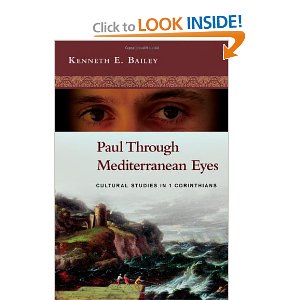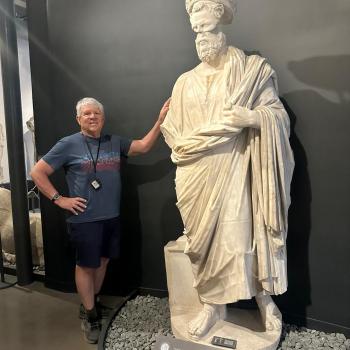At several junctures in the book, Bailey assumes that the temple of Aphrodite had numerous sacred prostitutes in Paul’s day (see e.g. p. 276). The problem is, this temple was apparently destroyed in the second century B.C. and all textual references to the hierodulae of that temple are referring to the situation prior to 146 B.C. There may have been such a temple in Paul’s day, but we would need some concrete evidence that it was a ‘business as usual’ situation when it came to the prostitutes. When Paul talks about prostitutes (see 1 Cor. 6) he does not directly associate them with some specific religious facility in Corinth, though since he mentions them in the context of a meal discussion he may be referring to dalliance with serving girls in pagan temple dining rooms also referred to in the reference to ‘play’). Lets be clear however that those sorts of liasons did not involve ‘sacred prostitutes’ from the temple of Aphrodite. (See Conflict and Community in Corinth pp. 191ff.).
P. 280 last line… a rare typo—it should be identity not identify here.
One of the upshots of Bailey’s approach to the structures within 1 Corinthians is that time and again he wants to argue that the actual climax of this homily or that, this section or that, is in the middle of the homily, not at the end. Besides the fact that this analysis doesn’t work in various cases with the units Paul is presenting, it would make Paul a very confusing communicator to the majority of his audience which: 1) did not know Hebrew; 2) did not know the OT, and 3) did indeed know the structures of Greco-Roman rhetoric and how those sorts of rhetorical units and arguments worked. They worked in a linear fashion, not only in the whole discourse, where there was a peroration at the end of the discourse summing up and drawing to a conclusion and climax the whole discourse with an emotional appeal, but likewise individual arguments along the way, while they may sometimes have some A,B,A structuring (see 1 Cor. 8-10), they are predominantly linear in character. Thus 1 Cor. 10 concludes the discussion raised in 1 Cor. 8. The failure to come to grips with the actual linear character of Paul’s arguments in Greek for Greek speakers is a significant failure (see e.g. pp. 290-92). We could compare his treatment of 1 Cor. 11-14. The climax of this argument is not in 1 Cor. 13. That is a discussion of love as the more excellent way to use one’s spiritual gifts. The discussion moves along in a linear fashion as Paul walks through the use of gifts in worship including in the Lord’s Supper, concluding with a discussion how the use of prophecy and tongues can be done in a fashion that produces concord not division, harmony not dissonances.
Nevertheless, Bailey, as one would expect, makes many good points about cultural sensitivity and cultural accommodation in his treatment of 1 Cor. 8-10. As he says, there are something which Christians can accept about a culture whole heartedly and participate in them. There are some things Christians can accept partially, being critically discerning, and there are some things, like worshipping in a pagan temple and participating in idols feasts that Christians must have nothing to do with. Knowing which is which is critical. It is surprising though that Bailey does not talk more about the issue of ‘things indifferent’. Yes, food has been declassified when it comes to the issue of clean and unclean. It should not raise issues of conscience. That being said, there are other things, other Levitical laws no longer applicable as well. It is not just freedom or love that guides one’s decision-making, it is also one’s conscience, which Paul doesn’t want anyone defiling. Anything one cannot do in good faith is sin for that person, a violation of conscience, and should not be engaged in.
On p. 297, Bailey rightly stresses that Paul’s use of tradition and use of the traditional formula “I passed on to you…what I received” makes clear that Paul didn’t start a Christian movement he joined one. This is exactly right. As creative and imaginative as Paul was, he was not the founder of the early Christian movement though he joined it early on, and furthermore, he was not the first creator of its traditions, as this use of these formulae show.
In his discussion of the much controverted issue of 1 Cor. 11.2ff. involving head-coverings and male and female prophets, Bailey begins by stressing that “the issue is gender distinctions, not gender subordination… Paul is talking about men and women who are leading public worship” (p. 300). That’s correct. Paul is not objecting to women praying and prophesying in the worship service, but he wants the gender distinctions reflected in worship. It is however a misstep, which Bailey makes, to assume that the dictum ‘all things are lawful to me’ was one Paul endorsed. Paul was not an antinomian, nor was he afraid of laying down the law when he needed to do so. He also mistakenly assumes that the Greek term hetaerae refers to sacred prostitutes. Nope. It refers to ‘companions’ high priced call girls that would accompany the well to do to certain events, including idol feasts. One of the oversights of Bailey’s discussion is that in Greco-Roman worship, when the sacrifice was being made, both men and women covered their heads. The issue is head-coverings in worship, not head-coverings in general or when one is out in public. Paul’s argument here involves setting up a Christian practice that can be distinguished from both Jewish and Greco-Roman practice. Jewish men did indeed cover their heads when they prayed, and Paul has no problems with the Corinthian men praying without a head-covering. In the debate over the meaning of kephale (p. 302),
Bailey chooses the term ‘origin’ (source), and rather than a translation ‘authority over’. The word can have either meaning depending on context. But since there is clearly an argument in this very passage about Adam being the source of Eve, (and men coming forth from women ever since then), and since Paul has already argued that Christ was co-creator with the Father, being the agent of creation, so Paul could clearly say ‘Christ is the origin of all humankind (see Col. 2), this translation makes good sense in this context. While Paul does not use the term monogenes (John 1) when talking about Christ’s origins in relationship to the Father, it does look like he affirmed this idea as well. Bailey also rightly deconstructs the creation order argument in terms of its implications about importance and authority. If precedence determined importance in the creation order, then animals would be more important than humans, plants than animals, and the bare form of the earth and the heavens the most important of all (p. 303). There is a mistake on p. 304—it asks what did Paul think a bareheaded man praying etc. dishonored Christ, his head? Paul didn’t. He thought a man with a head covering dishonored his head. One of the more significant problems with Bailey’s discussion here is he thinks Paul is talking about veils. He isn’t here but he does in 2 Cor. 3.12-18 in referring to Moses. Here Paul uses the term ‘something down from the head’ (i.e. a head-covering, not a face veil). So the whole business about Paul not wanting men’s faces to be veiled is not to the point here. The issue is metaphorical heads and symbolic head-coverings. Bailey then assumes that the issue has to do with women’s hair being a sexual excitement (he quotes a Jewish saying to this effect) or at least a distraction. But that is not the explanation Paul gives— he says it is because a woman’s hair is her glory, and no one’s glory should appear in worship except God’s. Why then would the angels come into the picture? Because they are traditionally the guardians of worship, the worship leaders in one sense (see Is. 6 for example— they cover themselves in three places, or in Revelation 4-5). But along these same lines, since only God’s glory should show up in worship, the husband’s glory should not— and the glory of the husband (man) is the woman (wife). Yes the terms often translated man and woman here can mean husband and wife. In any case, all glory should be hidden but God’s in worship.
Bailey is helpful is sorting out some of the mysteries of this text. For example, he stresses rightly (p. 310) that ‘dia’ can certainly mean the same thing in all four clauses which then would read ‘for man was not created because of the woman, but the woman because of the man. Because of this the woman should have authority on her head, because of the angels.’ The allusion is to Gen. 2.18. It was not the woman who needed a partner and could not manage alone. It was the man Eve then, was created as an ezera the very same word often used of God when he comes to help Israel. “The word ezer does not refer to a lowly assistant but to a powerful figure who comes to help someone who is in trouble… Women…are placed by God in the human scene as the strong who come to help the needy (the men).” (p. 310). Bailey is possibly right that the angels were also seen as guardians of the creation order, and since the creation order involves worshipping God properly, the idea is for women not to be out of order while praying or prophesying but rather wearing the symbol of their authority to do this—the head covering.
In his discussion of 1 Cor. 11.17-34, Bailey once again trots out the argument that Paul is following an A B A pattern, in this case with the recited early Christian tradition about the Last Supper being the ‘meat in the sandwich’ as he likes to put, and once again he sees this as a following of the style of chiastic rhetoric found in Isaiah (pp. 314-24). What’s wrong with this picture? One needs to ask the question how does the Last Supper tradition in 1 Cor. 11 function rhetorically. It does not function as a climax to a chiastic structure. It functions as an ‘inartificial proof’ brought in in the middle of an argument to strengthen the argument. The argument is ongoing and does not climax in the B section, as he labels it. It climaxes at the end of 1 Cor. 11. If we are talking patterns of argumentation the regular way Paul argues, for example, in Galatians 3 and in 1 Cor. 11 is: 1) he appeals to the experience of the audience which they cannot gainsay; 2) he appeals to Scripture or tradition as the second strongest form of argument; 3) he appeals to ‘nature’ or common customs as the weakest form of argument. We see all of this in the previous discussion about head-coverings, and in this order. The same can be said of 1 Cor. 11.17-34. In no case is Paul’s citing of Scripture or tradition the climax of any of these arguments. They are linear in character and follow Greco-Roman rhetorical patterns of what is most likely, second most likely, and least likely to persuade an audience largely made up of Gentiles.
On p. 320 we find an odd, but somewhat helpful discussion of 1 Cor. 11 in comparison with John 13. Bailey seems to think that in John 13, Judas rejects the bread. The text does not say so. Indeed, probably what is meant is ‘after he received the bread, Satan entered him’. So, the analogy with the abuse of the Eucharist in 1 Cor. 11 breaks down. Bailey however is certainly right about the shaming effect of rejecting hospitality in that culture, or abusing hospitality for that matter. It borders on sacrilege, and Paul treats it that way. Bailey applies the modern Middle Eastern tradition of dipping bread in sauce and handing it to another as a gesture of friendship and he applies this to John 13 when Jesus does this with Judas. This may be correct in Jesus’ case, but that is not how dining worked in the Greco-Roman world, where people reclined on couches with spouses or special guests.
On the vexed question of what it means to examine oneself discerning the body, and not partake in an unworthy manner, Bailey (p. 324) is probably right that Paul refers to discerning that one is partaking with and as part of the body of Christ (the reference is not to the elements), and about the other matter he says “the only believer who is unworthy to receive the Holy Communion is the person who thinks that he/she is worthy to receive it”, a nice aphorism. However Paul is not talking about people being worth, but partaking in an unworthy manner like the Corinthians who were gorging themselves and getting drunk.













